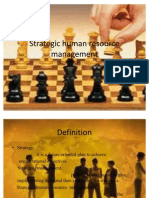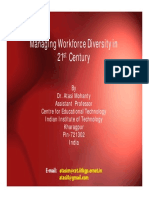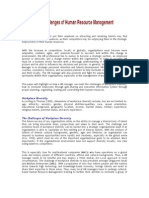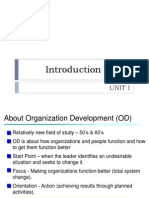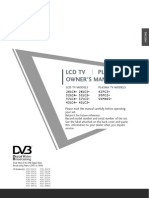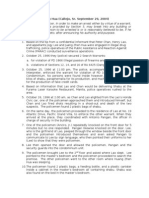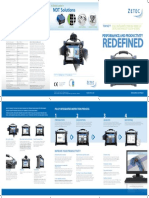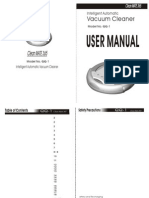Defining Diversity:: 1. Power Theory
Defining Diversity:: 1. Power Theory
Uploaded by
Ethan ChristopherCopyright:
Available Formats
Defining Diversity:: 1. Power Theory
Defining Diversity:: 1. Power Theory
Uploaded by
Ethan ChristopherOriginal Description:
Original Title
Copyright
Available Formats
Share this document
Did you find this document useful?
Is this content inappropriate?
Copyright:
Available Formats
Defining Diversity:: 1. Power Theory
Defining Diversity:: 1. Power Theory
Uploaded by
Ethan ChristopherCopyright:
Available Formats
Defining Diversity: Diversity means difference.
In an employment context, it means ensuring that organizations recruit and retain the best person from the widest possible talent base regardless of sexual orientation, age, race, religion or disability. It also means that organizations should recognize different approaches are required for different people who have different needs and expectations. The emphasis is placed on valuing difference as opposed to fitting in. Origins of Diversity: Diversity in the workplace was virtually non-existent until stronger voices among the minority workers slowly changed the work place from a single domain to better reflect a multi-cultural society. Factors include a declining overall population, increases in minority ethnic population and migrant workers, increasing numbers of women entering the workforce; people with disabilities challenging stereotypes. These changes will mean that traditional patterns of employment are changing together with employees also having higher expectations of their employers to accommodate their needs, through for example, flexible working and "work-life balance". Recognizing diversity means understanding how peoples differences and similarities can be mobilized for the benefit of the individual, the organization and society as a whole. Different groups of people offer different skills that can improve an organizations ability to deliver goods and services, adding value and sustainable competitive advantage. This holds true for all organizations whether they are large or small, public or private or not for profit sectors, including Trade Unions. Context of Diversity: The following theories assist in the understanding of which processes take place within multicultural co-operation in organizations: 1. Power theory If there is a situation of established people and outsiders the dominant or self-evident will be the norm and the minority is often described in negative terms as a deviation from the dominant, so forcing the minority party often to prove that his or her way of working is possibly different but need not necessarily be worse. 2. Token theory The token theory opens up a number of mechanisms which occur when one single individual has to operate within a majority/tokenism. Tokens are people with a symbolic function. They will always be in the spotlight and followed critically. Their reaction to that can be 'not to stand out' but also emphasizing their exceptional position or contrariwise to behave as a 'super specimen' of the majority.
In any case a token soon ends up in a special role in which there is little room for independent action. This is reinforced by the fact that the token is addressed as the representative. As a representative the token realizes that if she fails the next person from that same group will get it a lot tougher. Another pattern is that the majority starts behaving, consciously or unconsciously, as a group. The differences amongst the members of the majority appear to get smaller by the use of language, jokes, codes, communal experiences etc. The effect on the token can be a feeling of exclusion. A token then has the hard task of choosing to adapt and join in or to remain an appendage. 3. Identity theories Everyone has different identities: a sexual identity (man/woman), an ethnic identity (black/ white/immigrant), but also for example a job identity. People from minority groups often react from a victims role. To be a victim or to have been a victim is a genuine experience, despite the negative overtones. But this is not the most effective role when changes need to be achieved. People can take up a different position, that of warrior or strategist. The dominant groups too are often caught in a certain role, and can feel threatened or guilty. Here too it applies that there are developments possible for making alliances: what do we expect from each other and what can each person do from a different position in order to achieve as fertile a working climate as possible. Before an organization will reap the rewards of a diverse work environment, it's essential to have an infrastructure set up that not only supports diversity, but also celebrates it. The company's culture needs to reflect an environment where all employees feel comfortable and valued, and where offering their opinions are encouraged. Causes: Several phenomena have contributed to the prevalence of diversity in the modern workplace. The population of organizations is becoming more ethnically and racially diverse. Over decades, enforcement of civil rights and antidiscrimination laws has helped create an atmosphere of tolerance for individual differences. The median age of the population has also increased, meaning more older people are working. Finally, companies want to reach consumers in the global marketplace, and they need employees who understand consumer culture inside countries and overseas. For instance in software firms the academic background is not very diversified as compared to any educational institution where there are physicists, mathematicians, philosophers, architects, geologists, linguists, etc. This makes an interesting mix of perspectives. On the other hand exchange of idea and learning curve gradually becomes flat and employees in software firms start feeling detached to co-workers losing job satisfaction. To meet up with this challenge many biggies in this business have established global diversity councils. The Council's membership is
reflective of diverse workforce and business environment, thereby adding to the group's effectiveness. In public sector companies the age diversity plays the vital role. The age gap between a subordinate and its reporting authority is remarkably high which mostly leads to centralized power and diminishes career growth of the young population, which again leads to failed job satisfaction.. Gender discrimination in manufacturing units can be sited as a major challenge for HR department. Lack of recognition can be defined as a major cause behind attrition or poor performance of female employees. Another factor in this category may be special disabilities. However organizations are trying to meet up with such challenges. For instance some MNCs have teamed up to host a unique event for Private and Public sector organizations who are pro-active and keen to address Dyslexia in the workplace and are willing to make reasonable adjustments through the use of assistive software. Such workshop welcomes Diversity Managers, Human Resources Managers and Training & Development Managers who have an interest in products and practices that provide reasonable adjustments for staff with dyslexia in the workplace. Unconscious bias is a new way of describing an age-old problem. We can often see it in others, but its hard to know our own. It affects how we interact with people at work, the decisions we make and the way we manage. But because its unconscious, and because it goes to the core of who we are and how we think, mostly we keep it buried. These kinds of engaging sessions have surfaced in many manufacturing units, which explores unconscious bias, assumptions and first impressions - it gets people thinking and doing things differently. Using experiential techniques and talented facilitators, participants develop tools and techniques to understand their own biases, and challenge negative bahaviours in others. This session helps you to focus on inclusion and develop coaching techniques that foster an inclusive culture. Consequences: People from diverse backgrounds, be it race, age, gender, or geography, could approach a problem from different viewpoints, and, armed with a collective range of knowledge and experience, produce a better finished product. In order to overcome the differences in background, employees should downplay their personal identities in order to align themselves with the goals of the team. Groups with members who externalize their personal identities i.e. who express individuality are more successful than groups with members who tend to downplay their personalities. In essence, diversity indeed foster innovation but only if that diversity is embraced by the group. Our research indicates that expressing personal identities in groups seems to have beneficial effects because those who express themselves are more likely to feel known and understood, because they actually are better known and understood. Feeling known and understood causes people to open up, which can foster creative solutions to problems confronting the group.
An organization that recognizes and embraces employee diversity creates opportunities for people to interact in meaningful ways within the organization. That diversity can be leveraged, too. For example, large companies like Coke have historically set up affinity groups, which are cross-organizational teams set up with members from a similar demographic or social background. Setting up these groups may benefit your organization for a variety of reasons. First, such groups can teach new employees about the organizational culture, and educate them how to be successful within the company. Second, the group gives existing employees a way to develop relationships and connect with people across company groups. Perhaps most importantly, these groups can be used as resources for your company's marketing needs. By setting up mini-focus groups of an intended demographic, these affinity groups can gauge the effectiveness of a marketing campaign. Having a diverse workforce with a strong culture of individualism has profound effects on internal employee relations, but it can also assist in obtaining new clients. Diversity gives greater access because it is actually a building an environment where potential customers recognize a different element within organization. It all comes down to creating a vibe, or a feeling, that helps employees love being there. The employees transfer that feeling to the customers and bring them into the business.
You might also like
- Organizational Structure and Culture. Hofstede S Four DimensionsDocument13 pagesOrganizational Structure and Culture. Hofstede S Four DimensionsDes Arenas80% (5)
- 5eng FinalDocument14 pages5eng FinalCamilla RaceNo ratings yet
- WSDE PresentationDocument10 pagesWSDE PresentationChloe SNo ratings yet
- Importance of Strategic Human Resource ManagementDocument14 pagesImportance of Strategic Human Resource ManagementAngelo VillalobosNo ratings yet
- Manual Fuji YidaDocument140 pagesManual Fuji YidaPatricio Aguilar72% (18)
- Managing Workplace Diversity: Building Effective and Efficient Work RelationshipsFrom EverandManaging Workplace Diversity: Building Effective and Efficient Work RelationshipsNo ratings yet
- Evolution of HRMDocument22 pagesEvolution of HRMShalemRajNo ratings yet
- Managing Workplace DiversityDocument241 pagesManaging Workplace DiversityGiGi AdvinculaNo ratings yet
- Strategic Human Resource ManagementDocument31 pagesStrategic Human Resource ManagementNeha Sharma0% (1)
- Handbook of Human Resource Management in GovernmentFrom EverandHandbook of Human Resource Management in GovernmentStephen E. CondreyRating: 5 out of 5 stars5/5 (1)
- Partner 14 User GuideDocument255 pagesPartner 14 User GuideLoveness MahamboNo ratings yet
- Diversity Training That Generates Real Change: Inclusive Approaches That Benefit Individuals, Business, and SocietyFrom EverandDiversity Training That Generates Real Change: Inclusive Approaches That Benefit Individuals, Business, and SocietyNo ratings yet
- The Nature of PeopleDocument4 pagesThe Nature of PeopleArt FajardoNo ratings yet
- Management DiversityDocument8 pagesManagement Diversitykidszalor1412No ratings yet
- Managing Workplace DiversityDocument15 pagesManaging Workplace DiversityDenisa Elena Focaru100% (1)
- Strategic Human Resource ManagementDocument104 pagesStrategic Human Resource Managementdanisweet100% (1)
- Organizational CultureDocument25 pagesOrganizational CultureArcee Ardiente Mondragon100% (3)
- Chapter 3 and 4 Leadership Reflection Paper PearisDocument8 pagesChapter 3 and 4 Leadership Reflection Paper Pearisapi-301417503No ratings yet
- Importance of Organizational StructureDocument2 pagesImportance of Organizational StructureShivank KalaNo ratings yet
- Diversity ManagementDocument26 pagesDiversity Managementashutosh.inNo ratings yet
- Ii-Steps To Manage Diversity in WorkplaceDocument9 pagesIi-Steps To Manage Diversity in WorkplaceHakim Alami OuahabiNo ratings yet
- Employee Relations - Conflict ResolutionDocument13 pagesEmployee Relations - Conflict Resolutionkfls_8367% (3)
- Clearly Defined and Specialized Functions 2. Use of Legal AuthorityDocument3 pagesClearly Defined and Specialized Functions 2. Use of Legal AuthorityJane WambuiNo ratings yet
- Managing Workforce Diversity in 21st CenturyDocument15 pagesManaging Workforce Diversity in 21st CenturyNagendra Balaji100% (2)
- Effectively Manage Workplace DiversityDocument5 pagesEffectively Manage Workplace Diversityrao_pooja13No ratings yet
- Od InterventionsDocument4 pagesOd InterventionsPrithwiraj DebNo ratings yet
- Ethics in Organizational Development and ChangeDocument11 pagesEthics in Organizational Development and ChangeSameen Salman0% (1)
- CIPD Organisation Development FactsheetDocument6 pagesCIPD Organisation Development FactsheetayeshajamilafridiNo ratings yet
- Organisational CultureDocument59 pagesOrganisational CultureHerojianbuNo ratings yet
- Multi-Generational GapDocument2 pagesMulti-Generational GapPooja NagNo ratings yet
- Learning Reflection Record - 5UINDocument6 pagesLearning Reflection Record - 5UINEliza AlexeNo ratings yet
- Diversity RecruitmentDocument8 pagesDiversity RecruitmentRenushangar Raman100% (1)
- Od Intervention HRMDocument63 pagesOd Intervention HRMJohn Carlos WeeNo ratings yet
- Od Interventions: What Is Organization Development?Document33 pagesOd Interventions: What Is Organization Development?Jerry Sancho80% (5)
- OD-Six Box ModelDocument16 pagesOD-Six Box ModelNiraj Panpatil100% (1)
- Theories of Job SatisfactionDocument5 pagesTheories of Job SatisfactionIttba RafiqueNo ratings yet
- Training and Career Planning and DevelopmentDocument10 pagesTraining and Career Planning and DevelopmentBright Ideas EnterpriseNo ratings yet
- Introduction To OD: Unit IDocument22 pagesIntroduction To OD: Unit IAndinet HayilnewNo ratings yet
- Global HRMDocument23 pagesGlobal HRMPreeti Bhaskar100% (2)
- Important Issues in IHRMDocument3 pagesImportant Issues in IHRMsam130488No ratings yet
- Chap-4 OD PractitionerDocument24 pagesChap-4 OD Practitionernikunjptl06No ratings yet
- The Human Resources Management Strategies and Its Role in The AchievementDocument8 pagesThe Human Resources Management Strategies and Its Role in The Achievementindex PubNo ratings yet
- Recent Trends in Human Resource ManagementDocument6 pagesRecent Trends in Human Resource ManagementHoney Rasheed Memon100% (2)
- Organization CultureDocument19 pagesOrganization CulturediamblNo ratings yet
- Od Notes NewDocument108 pagesOd Notes NewAaron LeeNo ratings yet
- Job Satisfaction Level and Employee RetentionDocument89 pagesJob Satisfaction Level and Employee Retentionvipul99solankiNo ratings yet
- Ankit Agrawal Gopal Chaturvedi Priyanka: Presented byDocument22 pagesAnkit Agrawal Gopal Chaturvedi Priyanka: Presented bygopal8726100% (1)
- OD Interventions Case Study. An Employee Morale ProblemDocument7 pagesOD Interventions Case Study. An Employee Morale ProblemLopa Manish Shahi0% (1)
- Models of Human Resource Management Management EssayDocument6 pagesModels of Human Resource Management Management EssayHND Assignment HelpNo ratings yet
- Talent Management Strategy 3 1Document18 pagesTalent Management Strategy 3 1Farhan Rahman ArnobNo ratings yet
- Attracting and Hiring TalentDocument18 pagesAttracting and Hiring TalentMadhu Mahesh RajNo ratings yet
- Conflict MGTDocument19 pagesConflict MGTYasmeen AtharNo ratings yet
- Introduction To Human Resource Management: Reference BooksDocument29 pagesIntroduction To Human Resource Management: Reference BooksMalik Naseer AwanNo ratings yet
- A Critical Approach Towards An Integrative Dynamic Framework For Understanding - RosannaFerreiraDocument12 pagesA Critical Approach Towards An Integrative Dynamic Framework For Understanding - RosannaFerreiraRose Andrea FerreiraNo ratings yet
- OD InterventionsDocument6 pagesOD InterventionsRajdeep BhattacharyyaNo ratings yet
- Force Field Analysis - Kurt LewinDocument5 pagesForce Field Analysis - Kurt Lewinhoooza janaykaNo ratings yet
- OD Intervention PDFDocument9 pagesOD Intervention PDFNabeelNo ratings yet
- Case Studies On Group Behavior and Work PDFDocument27 pagesCase Studies On Group Behavior and Work PDFShriya Chhabra AroraNo ratings yet
- PH MSC Professional HRDocument382 pagesPH MSC Professional HRDr ShabbirNo ratings yet
- Chapter 12-Leadership HandoutDocument10 pagesChapter 12-Leadership HandoutAdil KiromNo ratings yet
- Business Culture and StrategyDocument18 pagesBusiness Culture and StrategyZihui PengNo ratings yet
- Handling Diversity in Organizational BehaviorDocument5 pagesHandling Diversity in Organizational BehaviorEthan ChristopherNo ratings yet
- Work Life Balance enDocument8 pagesWork Life Balance enankit_passiveNo ratings yet
- Work Life Balance enDocument8 pagesWork Life Balance enankit_passiveNo ratings yet
- IT Industry AnalysisDocument32 pagesIT Industry AnalysisEthan ChristopherNo ratings yet
- Eclipse 100 Introductory Course: Course Tutor: Eric Mackay 12 January 2007Document35 pagesEclipse 100 Introductory Course: Course Tutor: Eric Mackay 12 January 2007Anshul JhaNo ratings yet
- Chapter 13 - Marketing Mix - Promotion Business Studies IgcseDocument64 pagesChapter 13 - Marketing Mix - Promotion Business Studies IgcseRida AhmedNo ratings yet
- Euthenics Prelims CoverageDocument14 pagesEuthenics Prelims CoverageDarlene De PazNo ratings yet
- RODAN MANET LOOP Const PDFDocument64 pagesRODAN MANET LOOP Const PDFpraveen0907No ratings yet
- Working at Heights ProcedureDocument16 pagesWorking at Heights ProcedureHendrias Ari SujarwoNo ratings yet
- School of Cinematic Arts: SyllabusDocument8 pagesSchool of Cinematic Arts: SyllabusnnnnnatNo ratings yet
- Marketing Plan - Bread DelightDocument22 pagesMarketing Plan - Bread DelightStefan GonzalesNo ratings yet
- Electrozone Corporation ProfileDocument7 pagesElectrozone Corporation ProfileAli Rizvi0% (1)
- Schmatics Dell 7548 7547 Quanta AM6 MB - DA0AM6MB8E0 REV E PDFDocument58 pagesSchmatics Dell 7548 7547 Quanta AM6 MB - DA0AM6MB8E0 REV E PDFacsacrNo ratings yet
- LG 50PC55 User ManualDocument108 pagesLG 50PC55 User Manualxldoce4504No ratings yet
- Coaxial Cables - Solid or Stranded CoreDocument5 pagesCoaxial Cables - Solid or Stranded CoreRicardo Jose Flores GavidiaNo ratings yet
- FMV2107-FMV2307 Manual EngDocument60 pagesFMV2107-FMV2307 Manual EngRonald Peeters0% (1)
- ECONOMICS CAT 1 PresentationDocument14 pagesECONOMICS CAT 1 PresentationNeha GuptaNo ratings yet
- Online Aptitude Test - 4 Time and WorkDocument6 pagesOnline Aptitude Test - 4 Time and WorkAritra BanerjeeNo ratings yet
- Yes 95 No 5Document34 pagesYes 95 No 5sainiprateek88No ratings yet
- Business Insider-February 2021Document102 pagesBusiness Insider-February 2021Florian Petre GheorgheNo ratings yet
- People v. Huang Zhen HuaDocument3 pagesPeople v. Huang Zhen HuaNino HerreraNo ratings yet
- 2771947Document2 pages2771947aakashNo ratings yet
- Volkswagen-Finance Code-of-Conduct EN 2019Document28 pagesVolkswagen-Finance Code-of-Conduct EN 2019HongHaNguyenNo ratings yet
- Trends in Offensive Team Activity in BasketballDocument8 pagesTrends in Offensive Team Activity in BasketballCoach-NeilKhayechNo ratings yet
- Technical Note Modbus Implementation Using 3gen DTU Pro V1.2Document33 pagesTechnical Note Modbus Implementation Using 3gen DTU Pro V1.2Cássio Marcel Corghi de CamposNo ratings yet
- Redefined: Performance and ProductivityDocument2 pagesRedefined: Performance and Productivitysoffter2000No ratings yet
- 48 Garcia v. Robles Vda. de CaparasDocument3 pages48 Garcia v. Robles Vda. de CaparasKatrina Janine Cabanos-ArceloNo ratings yet
- BM101CDocument2 pagesBM101CEmily ResuentoNo ratings yet
- Cleanmate qq1 User - ManualDocument11 pagesCleanmate qq1 User - ManualsdmorehouseNo ratings yet
- Spring 2018 Lab Assignment #4: Understanding Cache Memories Assigned: Apr. 25 Deadline: May 9, 04:59:59 PMDocument10 pagesSpring 2018 Lab Assignment #4: Understanding Cache Memories Assigned: Apr. 25 Deadline: May 9, 04:59:59 PMSohaib ChoudharyNo ratings yet
- Printing Business For SaleDocument9 pagesPrinting Business For SaleSMM DATANo ratings yet
- TN-988 - Ink Tank Gasket KitDocument3 pagesTN-988 - Ink Tank Gasket Kitmarcos.terezanNo ratings yet








